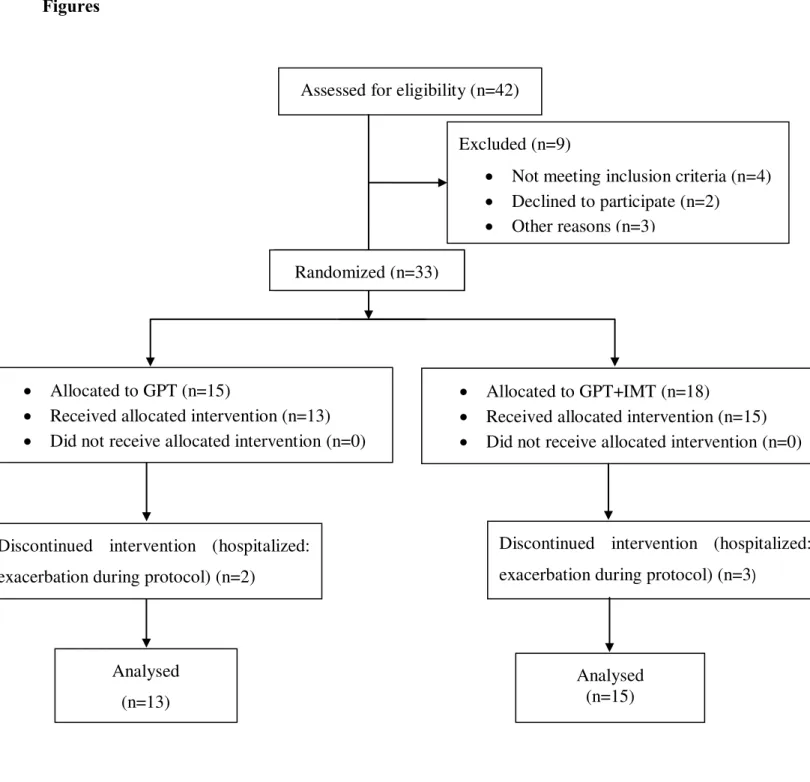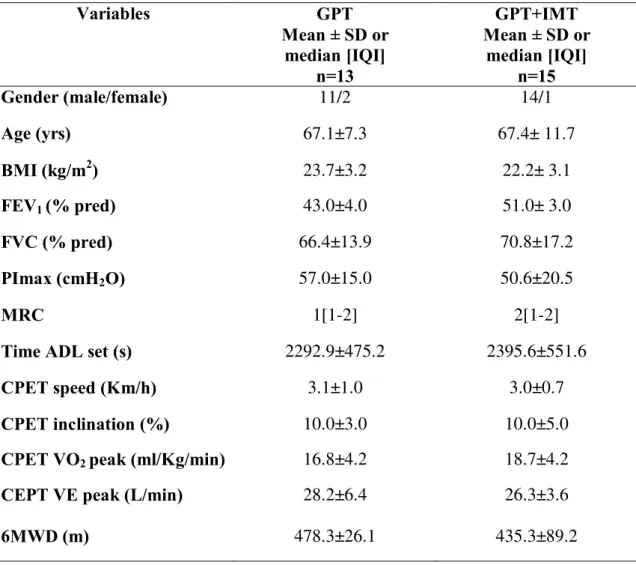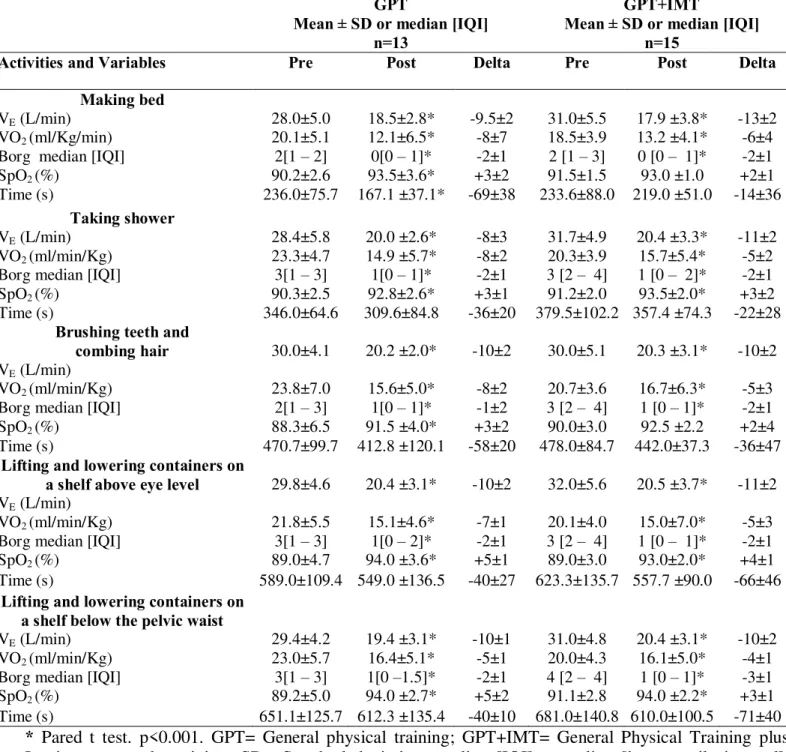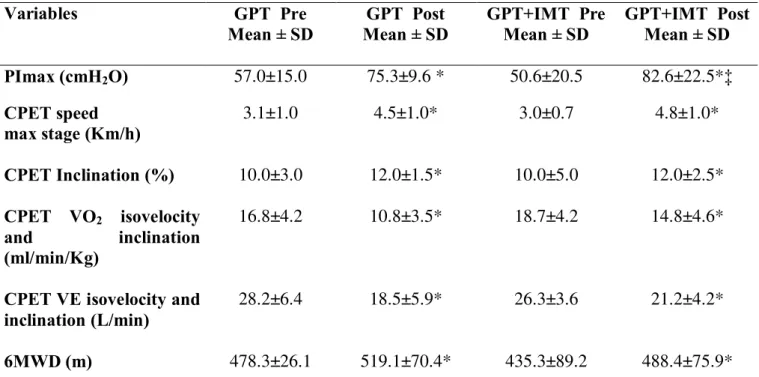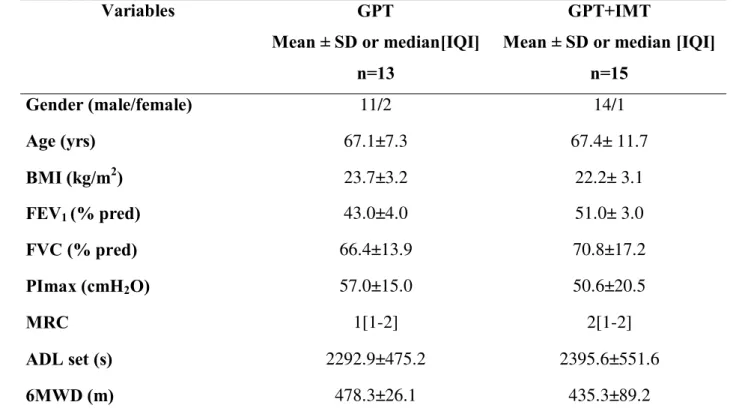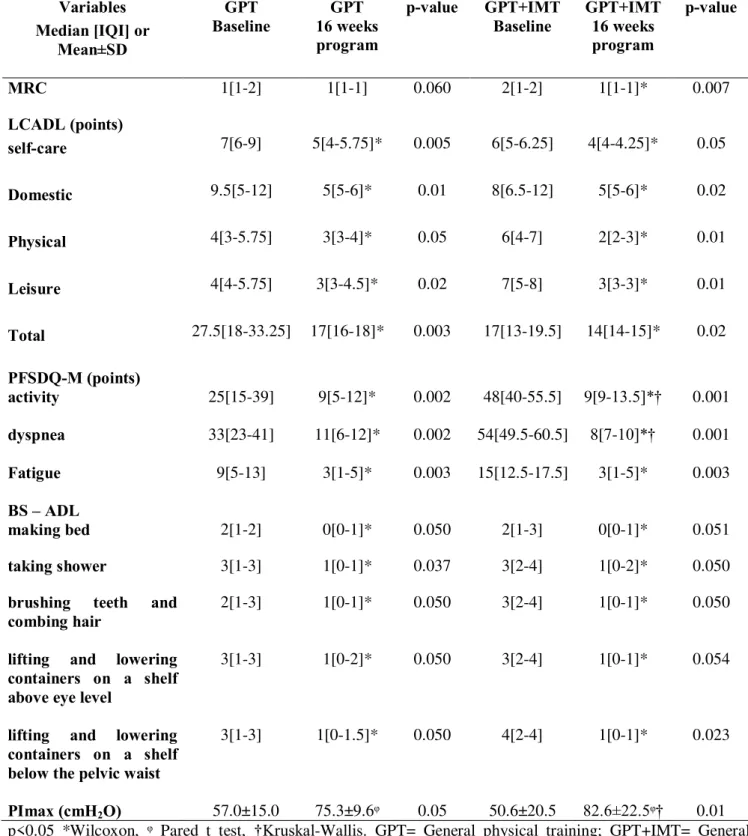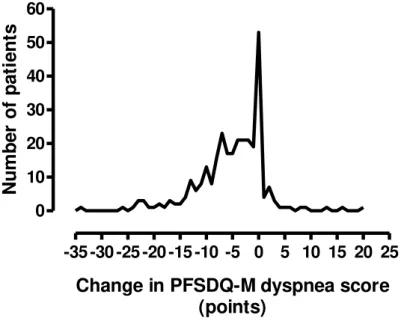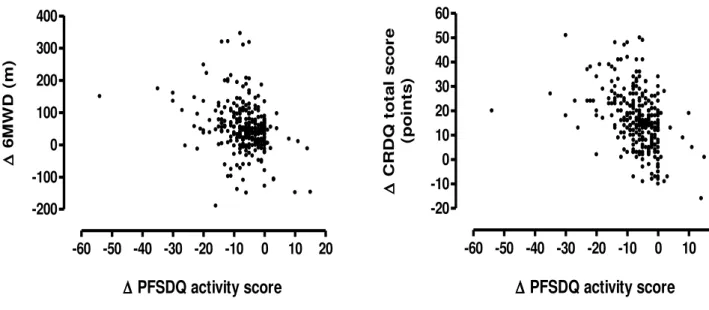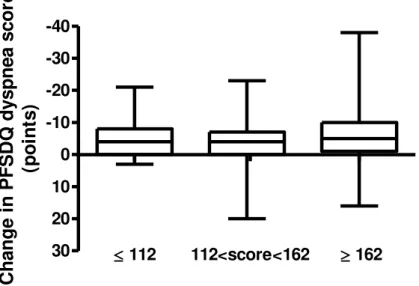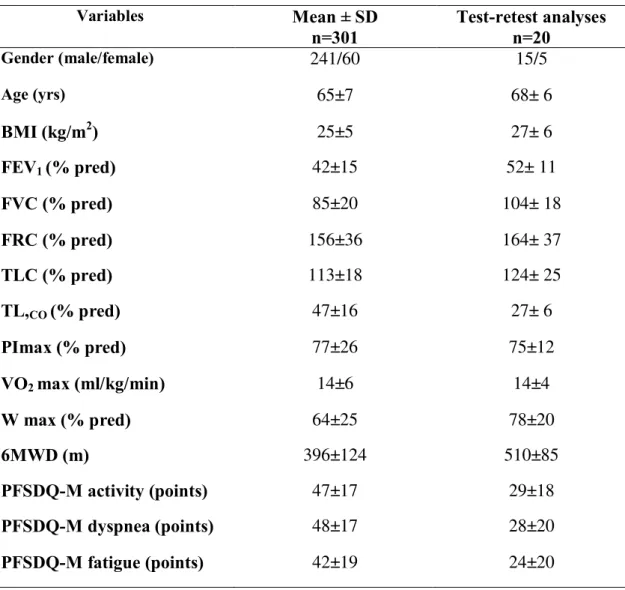____________________________________________________________________
ELOISA MARIA GATTI REGUEIRO
FUNCTIONAL STATUS AND DYSPNEA AS PERFORMANCE OF
ACTIVITIES OF DAILY LIVING AFTER PHYSICAL AND
INSPIRATORY MUSCLE TRAINING IN PATIENTS WITH
CHRONIC OBSTRUCTIVE PULMONARY DISEASE
1 STUDY I: Physiological performance of patients with COPD during activities of daily living after a physical training with and without inspiratory muscle training: pilot study.
1 STUDY II: Dyspnea and functional status: responsiveness of measuring instruments on the activities of daily living post different training programs in patients with COPD.
2 STUDY III: The Minimal Important Difference of the Pulmonary Functional Status and Dyspnea Questionnaire - Modified version in Patients with Chronic Obstructive Pulmonary Disease.
SÃO CARLOS – SP
2012
ELOISA MARIA GATTI REGUEIRO
FUNCTIONAL STATUS AND DYSPNEA AS PERFORMANCE OF
ACTIVITIES OF DAILY LIVING AFTER PHYSICAL AND
INSPIRATORY MUSCLE TRAINING IN PATIENTS WITH
CHRONIC OBSTRUCTIVE PULMONARY DISEASE
SÃO CARLOS – SP
2012
Ficha catalográfica elaborada pelo DePT da Biblioteca Comunitária/UFSCar
R344fs
Regueiro, Eloisa Maria Gatti.
Functional status and dyspnea as performance of activities of daily living after physical and inspiratory muscle training in patients with chronic obstructive pulmonary disease / Eloisa Maria Gatti Regueiro. -- São Carlos : UFSCar, 2013.
104 f.
Tese (Doutorado) -- Universidade Federal de São Carlos, 2012.
1. Fisioterapia respiratória. 2. Doença Pulmonar
Obstrutiva Crônica (DPOC). 3. Atividades de vida diária. 4. Exercícios físicos. 5. Treinamento muscular inspiratório. 6. Mínima diferença clinicamente importante. I. Título.
EPÍGRAFE
"Deus nos fez perfeitos e não escolhe os capacitados, capacita os escolhidos. Fazer ou não fazer
algo só depende de nossa vontade e perseverança”.
(Albert Einstein)
Pois...
"Nada na vida deve ser temido, somente compreendido. Agora é hora de compreender mais para temer menos." (Marie Curie)
Visto que...
“Quando nada é certo, tudo é possivel.”
DEDICATÓRIA
Aos meus pais Shirlei e Célio, pela minha vida, pelo que sou, pelo meu caráter, pela educação que me proporcionaram em todos os âmbitos: no sentido familiar, técnico e educativo; e consequentemente pelo incentivo e apoio em todas as decisões, quaisquer fossem os obstáculos.
Ao meu amor Rodolfo, pelo apoio e incentivo em todas as escolhas de nossas vidas e ao longo da minha jornada acadêmica; pela paciência, pelo cuidado, companheirismo, amor e carinho incondicionais ao longo desses anos.
AGRADECIMENTOS
A Deus, por tornar possível minha caminhada pessoal e profissional ao longo dessa vida.
À minha orientadora Profa. Dra. Valéria A Pires Di Lorenzo por ser a coluna mestre na construção de minha formação acadêmica e científica.
A Prof. Dr. Dirceu Costa pelo exemplo de sabedoria humana e científica e pelas oportunidades que esse exemplo me trouxe.
Ao Prof. Dr. Mauricio Jamami pelo apoio e auxílio ao longo dos anos no laboratório.
My gratitude to Prof. Dr. Thierry Troosters for his scientific input, intelligence and commitment with our proposal during the doctoral stage at Katholieke Universiteit Leuven.
My gratitude to Prof. Dr. Rik Gosselink for his support during my time as a student in Leuven. Additionally, for his constructive remarks and time devoted to my academic life at Katholieke Universiteit Leuven while I was there.
Aos Professores da banca examinadora, Profa. Dra. Armèle De Fátima Dornelas, Profa. Dra. Eli Maria Pazzianotto Forti, Prof. Dr. Marcelo Velloso e Prof. Dr. Michel Silva Reis por suas sugestões e críticas construtivas, pelo seu conhecimento profissional, clínico – científico, que certamente enriqueceram essa tese.
À amiga Ivana, por sua amizade e doação sem medir esforços, especialmente na etapa final. Sua dedicação e auxílio foram primordiais.
A toda equipe e colegas do Laboratório de Espirometria e Fisioterapia Respiratória da UFSCar.
Ao pneumologista Dr. Antonio Delfino de Oliveira Junior.
My appreciation and gratitude for the professionals and colleagues Chirs Burtin, Daniel Langer and Hans Van Hemoortel, to all academic support and to their friendship during my stage in Leuven.
Aos colegas do Centro Universitário Claretiano e Centro Universitário Unifafibe pelo apoio, aprendizado e oportunidades em minha novata carreira como docente. A Profa. Jacqueline Vianna, ao Prof. Luiz Fernando Selistre, ao Prof. Oswaldo Taube e especialmente as professoras e amigas Bia Gurian, Bete Flauzino e Ligia Sousa.
A Profa. Carolina Tomazella, pelo profissionalismo e amizade e, sobretudo pela correção da língua inglesa dispensada a esse trabalho.
Aos meus alunos Saulo Cesar Vallin Fabrin e Caroline Ramos Martins pelo auxílio na tabulação dos dados.
Ao pacientes, pelo que me ensinaram e pelo que aprendi. Sem os quais a realização deste estudo não seria possível.
Por fim e não menos importante, aos meus...
Ao meu amor Rodolfo por mais essa jornada, pelo apoio, incentivo e pela perspectiva de juntos construirmos uma vida e nossas carreiras; alicerçadas não apenas em plena confiança e respeito mútuos, mas, sobretudo Amor, sob as bênçãos de Deus e de nossas famílias.
Aos meus pais, Shirlei e Célio que me deram a vida e ensinaram-me a vivê-la com dignidade.
Por entender e respeitar minhas peculiaridades e objetivos ao longo da vida. Por compartilhar sempre dos meus ideais e por jamais medir esforços para realizá-los e, sobretudo, pelo amor que há entre nós.
Aos meus irmãos Rafael e Elisa pelo amor, solidariedade e compreensão.
Aos meus avós pelo que me ensinaram e pela tradução da palavra amor.
Aos meus tios, em especial Titio e Titia, pelo que representam em minha vida.
Aos meus primos, pelo amor que existe entre nós.
Em especial aos meus primos Zeza e Jon pela oportunidade de um novo aprendizado, pela experiência de vida, por me acolher e financiar meus estudos em Brisbane.
Sem eles esse passo não seria dado. My gratitude!
LIST OF ABBREVIATIONS
ADL Activities of daily life BMI Body mass index BS Borg scale
COPD Chronic Obstructive Pulmonary Disease CPET Cardiopulmonary exercise test
CRDQ Chronic Respiratory Disease Questionnaire ECG Electrocardiogram
ERES Empirical rule effect size ES Effect size
FEV1 Forced expiratory volume in one second FVC Forced vital capacity
GOLD Global Initiative for Chronic Obstructive Lung Disease GPT General physical training
GPT+IMT General physical training + inspiratory muscle training HR Heart rate
HRQoL Health-related quality of life ICC Intra-class correlation coefficient IMT Inspiratory muscle training [IQI] Interquartile interval LL Lower limb
LCADL London Chest Activity of Daily Living MID Minimal important difference
PFSDQ-M Pulmonary Functional Status and Dyspnea Questionnaire – Modified version PImax Maximal inspiratory pressure
PR Pulmonary rehabilitation RR Respiratory rate
SD Standard deviation
SEM Standard error of measurement SpO2 Peripheral oxygen saturation UL Upper limbs
VE Pulmonary ventilation
VE/VO2ratio Ventilatory equivalent for oxygen VO2 Oxygen consumption
TABLE OF CONTENTS
EPÍGRAFE...
...iii
DEDICATÓRIA
...v
AGRADECIMENTOS ...
...vii
LIST OF ABBREVIATIONS...xi
CHAPTER 1: GENERAL INTRODUCTION AND RATIONALE...14
CHAPTER 2: STUDY I ... 24
CHAPTER 3: STUDY II ... 45
CHAPTER 4: STUDY III ... 66
CHAPTER 5: FUTURE DIRECTIONS ... 97
CHAPTER 1: GENERAL INTRODUCTION AND RATIONALE
Activities of Daily Living, Dyspnea and Inspiratory Muscle Training in Patients with COPD
Chronic obstructive Pulmonary Disease (COPD) is a disease with high clinical and economic burden. By the year 2030 COPD will be among the top five chronic diseases in terms of global mortality and morbidity (1). The disease is equally present in developing and developed countries. The condition is associated with a substantial utilization of health care resources as a result of hospital admissions and the need for ongoing outpatient care(2) . The low level of spontaneous physical activity reduces the performance of these patients (3)and contributes to the development of skeletal muscle weakness and comorbidity. Patients often experience shortness of breath and a decline in exercise tolerance, resulting in disability in the performance of activities of daily living (ADL).
The kind of daily activities affected are mainly activities such as bathing, carrying things or walking up stairs, which determine a person’s ability to move around or the level of care that
the course of the disease physiological limitation begins to have its effects in daily life and/or activity level is reduced(8).
Additionally, several studies (9;10) show the added value of inspiratory muscle training (IMT) in conjunction with general exercise training in patients with COPD to improve the inspiratory muscle strength and endurance and decrease the dyspnea sensation. These data are in accordance with a recent review of Gosselink et al(11). They concluded that IMT is an effective treatment modality in patients with COPD to improve respiratory muscle strength and endurance. Moreover, it reduces dyspnea and improves the functional exercise capacity and health-related quality of life (HRQoL). Their findings evidenced that patients with more advanced muscle weakness seem to be better responders, especially when considering IMT in addition to general exercise training (11). However, there are no studies reporting the potential benefits of IMT on ADL. Furthermore, few studies investigated the metabolic and ventilatory demand of ADL in patients with COPD (6;7) after a rehabilitation program or a physical training, justifying our study.
Instruments to Quantify Dyspnea and Functional Status at COPD
international literature, mainly because it is easy to apply and understand. The London Chest Activity of Daily Living (LCADL), which has four domains (personal care, household activities, physical activities, and leisure activities), was developed with the aim of assessing the impairment of ADL in patients with COPD (18). The scale has proven to be a reliable, valid, and sensitive instrument for assessing patients’ response to pulmonary rehabilitation programs(18) .In addition, the Pulmonary Functional Status and Dyspnea Questionnaire - Modified version (PFSDQ-M) that quantifies the functional performance (change in activity levels), dyspnea and fatigue related to ADL experienced by patients compared to the period before disease onset in 10 common activities, is also a clinically useful instrument (19). Although there are studies that evaluate scales and questionnaires related to changes in ADL and dyspnea in patients with COPD, just few reports in literature compare and correlate the results obtained by those with metabolic and ventilatory responses before and after pulmonary rehabilitation program, during the simulation of daily tasks.
The clinical importance of benefits from intervention is the key to truly value their addition in the therapeutic armentarium. In this context, findings of the minimal important difference (MID) of an interested domain, which is defined as “the smallest difference in score in the
domain of interest which patients perceive as beneficial and which would mandate, in the
absence of troublesome side effects and excessive cost, a change in the patient’s
management” (20-22), have been extensively studied for functional exercise tests (23-25) and HRQoL (26).
orientation on what constitutes the MID for this patient reported outcome (27). Methods are available to establish a degree of change that could be considered different as well as clinically meaningful. Currently it is unknown which change in PFSDQ-M score should be considered a clinically relevant change. Approaches to establish the threshold for the PFSDQ-M would obtain the measures of improvement of dyspnea, fatigue and change in ADL and in six minute walk distance (6MWD) with a pulmonary rehabilitation program.
Rationale of the studies
In Chapter 2, the Study I of this thesis aims to investigate changes on perception of dyspnea (Borg scale), metabolic and ventilatory responses during a standard set of ADL tasks after a physical training and physical training plus inspiratory muscle training (Conducted in Brazil – UFSCar, São Carlos). Despite, it is already known that exercise training improves exercise capacity, the performance of activities of daily living, decreases dyspnea, and enhances the inspiratory muscle strength in patients with COPD (5;9), less is known on the physiological benefits (ventilatory and metabolic responses) during the execution of daily life activities (ADL) in patients going through physical training with additional or non-additional inspiratory muscle training (IMT). However, it is unknown to what extent pulmonary rehabilitation programs aimed at enhancing also respiratory muscle function, may affect oxygen uptake, ventilation, execution time and symptoms in patients with COPD during the execution of ADL tests.
inspiratory muscle training on symptoms (Conducted in Brazil – UFSCar, São Carlos). Patients with COPD often experience shortness of breath and a decline in exercise tolerance, resulting in disability to perform occupational and activities of daily living (ADL). Although there are studies that evaluate scales and questionnaires related to changes in ADL and dyspnea in patients with COPD(28), just few reports in the literature compare the results obtained by those in the simulation of daily tasks before and after a general physical training and physical training associated to IMT(10;29). Hence, our hypothesis is that the performance of ADL, the dyspnea and functional status reported from BS, the LCADL and the PFSDQ-M domain are improved with the IMT combined with general exercise training in patients with COPD.
Chapter 4 provides information regarding the use of specific tools, questionnaires and scales, to quantify dyspnea allow to classify the severity of the symptom and the distress generated thereby, and to monitor it over time, determination of the MID of these tools is important for several reasons, as it facilitates judging the magnitude of the benefit when comparing two treatments, calculating sample sizes, making inferences about the percentages of patients improved by a therapeutic intervention (e.g. the number needed to treat), and making cost effectiveness comparisons (30). Currently it is unknown which change in PFSDQ-M score can be considered as a clinically relevant change. Establishing the threshold of MID for the PFSDQ-M would add to the interpretation of the improvement of dyspnea and fatigue symptoms and change in ADL after a pulmonary rehabilitation (PR) program (31;32). Due to the importance of this field the Study III aims to establish the minimal important difference of the PFSDQ-M in patients with COPD (Conduced in Belgium – KU Leuven, Leuven).
A summary regarding the main findings of this thesis and future directions is provided in Chapter 5.
Studies
Reference List
(1) Carrasco GP, de Miguel DJ, Rejas GJ, Centeno AM, Gobartt VE, Gil de MA, et al. Negative impact of chronic obstructive pulmonary disease on the health-related quality of life of patients. Results of the EPIDEPOC study. Health Qual Life Outcomes 2006;4:31.
(2) Redelmeier DA, Bayoumi AM, Goldstein RS, Guyatt GH. Interpreting small differences in functional status: the Six Minute Walk test in chronic lung disease patients. Am J Respir Crit Care Med 1997 Apr;155(4):1278-82.
(3) Sandland CJ, Morgan MD, Singh SJ. Patterns of domestic activity and ambulatory oxygen usage in COPD. Chest 2008 Oct;134(4):753-60.
(4) Lacasse Y, Goldstein R, Lasserson TJ, Martin S. Pulmonary rehabilitation for chronic obstructive pulmonary disease. Cochrane Database Syst Rev 2006;(4):CD003793.
(5) Troosters T, Casaburi R, Gosselink R, Decramer M. Pulmonary rehabilitation in chronic obstructive pulmonary disease. Am J Respir Crit Care Med 2005 Jul 1;172(1):19-38.
(6) Velloso M, Stella SG, Cendon S, Silva AC, Jardim JR. Metabolic and ventilatory parameters of four activities of daily living accomplished with arms in COPD patients. Chest 2003 Apr;123(4):1047-53.
(7) Jeng C, Chang W, Wai PM, Chou CL. Comparison of oxygen consumption in performing daily activities between patients with chronic obstructive pulmonary disease and a healthy population. Heart Lung 2003 Mar;32(2):121-30.
(9) Geddes EL, O'Brien K, Reid WD, Brooks D, Crowe J. Inspiratory muscle training in adults with chronic obstructive pulmonary disease: an update of a systematic review. Respir Med 2008 Dec;102(12):1715-29.
(10) Beckerman M, Magadle R, Weiner M, Weiner P. The effects of 1 year of specific inspiratory muscle training in patients with COPD. Chest 2005 Nov;128(5):3177-82.
(11) Gosselink R, De VJ, van den Heuvel SP, Segers J, Decramer M, Kwakkel G. Impact of inspiratory muscle training in patients with COPD: what is the evidence? Eur.Respir.J 2011 Feb;37(2):416-25.
(12) Borg G. Perceived exertion as an indicator of somatic stress. Scand J Rehab Med 1970;2:92-8.
(13) Borg GA. Psychophysical bases of perceived exertion. Sports Exerc 1982;14:377-81.
(14) Ries AL. Minimally clinically important difference for the UCSD Shortness of Breath Questionnaire, Borg Scale, and Visual Analog Scale. COPD. 2005 Mar;2(1):105-10.
(15) Vaes AW, Wouters EF, Franssen FM, Uszko-Lencer NH, Stakenborg KH, Westra M, Meijer K, Schols AM, Janssen PP, Spruit MA. Task-related oxygen uptake during domestic activities of daily life in patients with COPD and healthy elderly subjects. Chest 2011 Oct;140(4):970-9.
(16) Kovelis D, Segretti NO, Probst VS, Lareau SC, Brunetto AF, Pitta F. Validation of the Modified Pulmonary Functional Status and Dyspnea Questionnaire and the Medical Research Council scale for use in Brazilian patients with chronic obstructive pulmonary disease. J Bras Pneumol 2008 Dec;34(12):1008-18.
(17) Bestall JC, Paul EA, Garrod R, Garnham R, Jones PW, Wedzicha JA. Usefulness of the Medical Research Council (MRC) dyspnoea scale as a measure of disability in patients with chronic obstructive pulmonary disease. Thorax 1999 Jul;54(7):581-6.
(19) Lareau SC, Meek PM, Roos PJ. Development and testing of the modified version of the pulmonary functional status and dyspnea questionnaire (PFSDQ-M). Heart Lung 1998 May;27(3):159-68.
(20) Juniper EF, Guyatt GH, Willan A, Griffith LE. Determining a minimal important change in a disease-specific Quality of Life Questionnaire. J Clin Epidemiol 1994 Jan;47(1):81-7.
(21) Jaeschke R, Singer J, Guyatt GH. Measurement of health status. Ascertaining the minimal clinically important difference. Control Clin Trials 1989 Dec;10(4):407-15.
(22) Guyatt GH, Osoba D, Wu AW, Wyrwich KW, Norman GR. Methods to explain the clinical significance of health status measures. Mayo Clin Proc 2002 Apr;77(4):371-83.
(23) Holland AE, Hill CJ, Rasekaba T, Lee A, Naughton MT, McDonald CF. Updating the minimal important difference for six-minute walk distance in patients with chronic obstructive pulmonary disease. Arch Phys Med Rehabil 2010 Feb;91(2):221-5.
(24) Singh SJ, Jones PW, Evans R, Morgan MD. Minimum clinically important improvement for the incremental shuttle walking test. Thorax 2008 Sep;63(9):775-7.
(25) Puhan MA, Chandra D, Mosenifar Z, Ries A, Make B, Hansel NN, et al. The minimal important difference of exercise tests in severe COPD. Eur Respir J 2011 Apr;37(4):784-90.
(26) Puhan MA, Frey M, Buchi S, Schunemann HJ. The minimal important difference of the hospital anxiety and depression scale in patients with chronic obstructive pulmonary disease. Health Qual Life Outcomes 2008;6:46.
(27) Guyatt GH, Feeny DH, Patrick DL. Measuring health-related quality of life. Ann Intern Med 1993 Apr 15;118(8):622-9.
(28) Crisafulli E, Clini EM. Measures of dyspnea in pulmonary rehabilitation. Multidisciplinary Respiratory Medicine 2010;5(3):202-10.
(30) Redelmeier DA, Guyatt GH, Goldstein RS. Assessing the minimal important difference in symptoms: a comparison of two techniques. J Clin Epidemiol 1996 Nov;49(11):1215-9.
(31) Nici L, Donner C, Wouters E, Zuwallack R, Ambrosino N, Bourbeau J, et al. American Thoracic Society/European Respiratory Society statement on pulmonary rehabilitation. Am J Respir Crit Care Med 2006 Jun 15;173(12):1390-413.
CHAPTER 2: STUDY I
Physiological performance of patients with COPD during activities of daily living after a physical training with and without inspiratory muscle training: pilot study.
Manuscript in preparation for submission
Abstract
Background: Exercise training improves exercise capacity, the performance of activities of
Introduction
Exercise training improves exercise capacity, the performance of activities of daily life (ADL), decreases dyspnea (5;33), which seriously symptom that affects patients’ capacity to
aimed at enhancing also respiratory muscle function, may affect oxygen uptake, ventilation, execution time and symptoms in patients with COPD during the execution of ADL tests. In the last few years two protocols have been developed harm to specifically measure ADL as a representative, objective assessment of function in patients with COPD. The Glittre ADL test (46) and the protocol described by Velloso et al (6)are available to test metabolic and ventilatory parameters of patients with COPD during ADL. The latter has been adapted for use in other studies (15;47). This study aimed to compare changes on ventilatory and metabolic responses ( E and O2), Borg symptom scores, peripheral oxygen saturation (SpO2) and execution time (s) of a standard set of ADL tasks between patients with COPD that performed two different training programs: an aerobic training, resistive exercise of lower limbs and a respiratory exercise program versus aerobic training, resistive exercise of lower limbs and inspiratory muscle training (IMT). We hypothesized that the ventilatory and metabolic responses during the performance of ADL, the dyspnea reported from Borg scale (BS), the SpO2 and execution time of a standard set of ADL tasks would ameliorate more in patients with COPD that performed the IMT.
Methods
Study design
Inclusion and exclusion criteria
Inclusion criteria were clinical diagnosis of COPD confirmed by post-BD spirometry administered by a pulmonologist, in accordance with the GOLD criteria(49), were clinically stable and had no history of infection and no exacerbation of respiratory symptoms or changes in medication for at least two months before the study, absence of severe cardiac disease as shown by electrocardiogram at rest and during the maximal exercise test, absence of other pathologic conditions which could impair the assessment of the ADL set, e.g. orthopedic and cerebrovascular diseases, malignancy, arthritis and rheumatism. Patients were excluded when the medication was modified during the study, in cases of exacerbation, uncontrolled arterial hypertension or hypoxemia (peripheral oxygen saturation [SpO2]) below 85% at rest), or for refusal to provide written informed consent.
Subjects
large muscle groups of the trunk) (mean ± SD age, 67.1±7.3 years; FEV1, 43.0±4.0% predictive) and 15 patients that performed the GPT+IMT with POWERBreathe® (mean ± SD age, 67.4± 11.7years; mean FEV1, 51.0±3.0% predictive) (Figure 1) (Table 1).
The procedures were performed according to the research ethics guidelines of the Declaration of Helsinki (50). The study protocol was approved by the ethics committee of Universidade Federal de São Carlos - UFSCar, Brazil (protocol number 140/2010) (Attachment I). Before the tests, the procedures were described in detail, and written informed consent was obtained from all patients (Attachment II). The patients did not receive any financial remuneration. Sample size calculation
Using data from our exercise training program and based on the estimated training effect on dyspnea, we determined that a sample size of 40 (20 per group) would yield 80% power (α= 0.05) to detect a between-group difference of 1.0 point at the minimal clinically important difference (MID) (14) on dyspnea in the Borg Scale during the assessment of the ADL set. Instruments and measures
All patients were submitted to a baseline and after protocol measures. Spirometry was performed using a portable spirometer (Easy One®) according to international standards (51) The results were expressed as the predictive percentage of Brazilian population (52). Maximal inspiratory pressure (PImax) was measured according to the method of Black and Hyatt (53) . The reference values were described by Neder et al (54).
A cardiopulmonary exercise test (CPET) was performed using a portable metabolic system
(MedGraphics VO2000 St. Paul MN, USA) to assess E and O2. The test consisted of
symptom-limited graded exercise on a treadmill with patient breathing room air and its
objective were to determine the training intensity and possible cardiovascular
Society/American College of Chest Physicians statement on cardiopulmonary exercise testing (56). The heart rate (HR) was monitored continuously by a 12-lead ECG. Functional exercise capacity was assessed by the 6MWT according to the American Thoracic Society recommendations (57).
Assessment of Activities of Daily Life task set
In the standard set of ADL tasks using a portable metabolic system (MedGraphics VO2000 St. Paul MN, USA) to assess E and O2, patients were evaluated by simulated ADL of: getting
up and making bed, taking shower and washing one’s back, brushing teeth and combing hair,
lifting and lowering containers on a shelf above eye level and lifting and lowering containers on a shelf below the pelvic waist. No specific amount of time is stipulated; the patient is only instructed to complete the task. The activities were adapted from Velloso et al (6). During the test, Borg symptom scores, SpO2 and execution time (s) were measured. Moreover, measures of blood pressure, respiratory rate (RR) and HR were measured in the rest (baseline) and in the end of the set, with the purpose of monitoring.
Training Protocol
The protocol consists of 48 sessions of 60 minutes each, three times per week on alternate weekdays in the outpatient clinic of the university. The aerobic training intensity consisted of 70-80% of treadmill speed and inclination reached in the maximal test symptom-limited, beginning from 20min and finishing with 30min. The training progression was periodically adjusted sustaining the HR in 85% of HRmax and Borg score ranging from 4 to 6. The resistive exercise of lower limbs (using free weights) was done with increment according to
additional inspiratory muscle training program performed using a threshold inspiratory muscle trainer, the POWERbreathe® (GaiamLtd; Southam, Warwickshire, UK). This equipment was used due to the load amplitude it can generate: from 10 to 90cmH2O (green –
Wellness model), increasing loads from 10 to 10cmH2O. During the protocol patients received IMT in 7 cycles of 2 minutes of resistive breathing each, followed by 1 minute of rest. They started breathing at a resistance that required generation of 15% of PImax for one week. The load was then increased incrementally 10% each session, to reach generation of 60% of the initial PImax at the end of the first month. IMT was then continued at 60% of the PImax adjusted every two weeks to the new PImax, achieved throughout the next 12-week course of the study (10;29). When oxygen saturation decreased below 90%, the intensity or the duration of the training was reduced. Pursed-lip breathing was used during training to
maintain the saturation. For hypoxemic patients and those who desaturate during training
(SpO2<88%), oxygen supplementation was provided (58).
Statistical Analysis
Results
The general characteristics of the 28 patients that completed the study are reported in Table 1. There were no statistically significant differences at baseline between the group GPT (n=13) and the group GPT+IMT (n=15). The patients understood the standardized instructions well. There were no adverse events during the ADL set Figure 1 provides the CONSORT chart of patients recruited up to those finishing the study.
Table 2 shows baseline and values after training for the ADL set for each group. While there were no significant changes in executing time in the majority of the ADL, there was statistically significant decrease (p<0.05) in values of E, O2, sensation of dyspnea (Borg) and ADL time (ADL making bed) and a significant improvement of SpO2 within groups. Additionally, change values of these variables after 4 month programs are shown in Table 2. There was no difference between groups after post training in the E, O2, SpO2, sensation of dyspnea and ADL time values.
Regarding to the ventilatory efficiency, ventilatory equivalents for oxygen ( E/ O2 ratio) and carbon dioxide ( E / CO2 ratio) no difference was found both, between and within groups in the ADL set before and post training programs.
Table 3 shows that the PImax (cmH2O) had a statistically significant rise (p<0.001) in GPT and GPT+IMT groups after training and between them. Regarding to CPET a significant fall (p<0.001) in the values of E, O2 at isovelocity and inclination were verified. There was no difference between them. Additionally, the 6MWD (m) had a statistically significant increase (p<0.001) in both groups with no difference between them (Table 3).
Discussion
reduced in both groups after training to perform the ADL set and that the GPT+IMT group shows higher improvement in the PImax than GPT group.
Since patients with COPD are limited in their activities, it is essential to apply simple and easy criteria in clinical practice. Thus, instruments that work with specific dimensions, such as the ADL, have proven to be useful in evaluating limitations in functional activities due to the deterioration of the disease. The application of this type of evaluation in pulmonary rehabilitation and physical training programs provides additional information on functional limitations and in the achievements on therapeutic strategies addressed to the program, such as specified physical training, mainly in patients with limitation to daily activities (59). The present study demonstrated that the E, O2 and dyspnea improved, showing fall levels in both groups after training and a rise of SpO2 levels. It is an important result as it is known that simple arm elevation (involved in many ADL) resulted in significant increase in metabolic and ventilatory requirements (6;7). However, as the result of both physical trainings, it improved. Hence the previously reported high levels of oxygen uptake and ventilation in patients with COPD during performance of ADL (8), confirmed in the present study can be reversed with exercise training. In line with observations in other studies (60;61), the addition of IMT did not show additional benefits in those variables when both groups were comparable. Both groups decreased in the values of E and O2.
While both rehabilitation programs seemed to result in clinically meaningful improvements in functional exercise tolerance (25) and dyspnea (14;32), the present study did not confirm the additional benefits of IMT on any of the selected outcome variables (physiological or patient report). In addition, also the group, not receiving IMT did enhance PImax. As there is no pure control group we can only speculate the nature of this improvement. Perhaps the respiratory muscle stretch exercises, which were introduced instead of the IMT may also impact on outcome, as these were also reported to decrease chest wall stiffness, particularly in the chest wall respiratory muscles. In addition, there might be an immediate effect of reducing dyspnea at rest (64) and in the respiratory weakness also observed in our study. These findings may also contribute to the fall of physiological variables during the ADL test as it was already quoted that simple arm elevation involved in many ADL resulted in significant increases in metabolic and ventilatory requirements (6;7)
Clinically relevant reduction in symptoms such as dyspnea and fatigue were also found(65); although there is no difference between GPT and GPT+IMT, such as in other studies (60;61). A change in the dyspnea after training of 1 point has been suggested as being the MID. Therefore the mean reduction of 2 points in the present study is likely indicative of clinical importance (14).
Another important outcome of the present study is the enhanced oxygen saturation during ADL activity. Oxygen saturation improved in both groups, with no additional improvement by adding IMT.
Clinical relevance
Limitations of the study
Limitations in the study should be considered. As a preliminary result, the sample size of 40 (20 per group) would yield 80% power (α= 0.05) to detect a between-group difference based on 1.0 point in Borg Dyspnea rating (14) sample size was not met as we were unable to recruit sufficient number of patients to complete the program on time, e.g. due to absence, adherence and time without any physical training of patients. Nevertheless, with the present data as pilot, we calculated that 40 patients would be required to find statistically significant differences between both groups. Altogether the benefits of IMT especially at ADL seem small and the clinical relevance can be debated. Eventually, no true control group was evaluated, so it is difficult to put the interesting reductions in pulmonary ventilation and oxygen consumption with ADL activities into perspective. These data therefore should be interpreted with caution. Nevertheless the data suggest that benefits of exercise training programs may reflect the relief of the symptoms in daily life through an improvement in mechanical efficiency and reductions in pulmonary ventilation when carrying out ADL tasks. Proper randomized and controlled studies are needed to further investigate the magnitude of this effect.
Conclusion
These preliminary results suggest that the assessed protocol trainings reduce metabolic cost of common tasks of daily life. The addition of IMT showed higher improvement of PImax when compared to a conventional training. However, it did not result in further benefits in activities of daily life.
Figures
Figure 1. Study design and allocation of subjects.
Assessed for eligibility (n=42)
Excluded (n=9)
Not meeting inclusion criteria (n=4) Declined to participate (n=2)
Other reasons (n=3)
Randomized (n= )
Allocated to GPT (n=15)
Received allocated intervention (n=13) Did not receive allocated intervention (n=0)
Allocated to GPT+IMT (n=18)
Received allocated intervention (n=15) Did not receive allocated intervention (n=0)
Analysed (n=13)
Analysed (n=15)
Discontinued intervention (hospitalized: exacerbation during protocol) (n=2)
Discontinued intervention (hospitalized: exacerbation during protocol) (n=3)
Tables
Table 1. Baseline characteristics of both groups: General Physical training and General physical training associated with inspiratory muscle training.
GPT= General physical training; GPT+IMT= General Physical Training plus Inspiratory muscle training; SD = standard deviation; [IQI] = interquartile interval; BMI= body mass index; FEV1 = forced expiratory volume in 1 second; FVC = forced vital capacity; PImax= maximum inspiratory pressure; MRC= Medical Research Council scale; CPET= cardiopulmonary exercise testing; VO2= oxygen consumption; VE = pulmonary ventilation; 6MWD = six minute walking distance.
Variables GPT
Mean ± SD or median [IQI]
n=13
GPT+IMT Mean ± SD or
median [IQI] n=15
Gender (male/female) 11/2 14/1
Age (yrs) 67.1±7.3 67.4± 11.7
BMI (kg/m2) 23.7±3.2 22.2± 3.1
FEV1 (% pred) 43.0±4.0 51.0± 3.0
FVC (% pred) 66.4±13.9 70.8±17.2
PImax (cmH2O) 57.0±15.0 50.6±20.5
MRC 1[1-2] 2[1-2]
Time ADL set (s) 2292.9±475.2 2395.6±551.6
CPET speed (Km/h) 3.1±1.0 3.0±0.7
CPET inclination (%) 10.0±3.0 10.0±5.0
CPET VO2 peak (ml/Kg/min) 16.8±4.2 18.7±4.2
CEPT VE peak (L/min) 28.2±6.4 26.3±3.6
Table 2. Baseline, 4-month training values and change values of both groups: General Physical training and General physical training associated with inspiratory muscle training.
* Pared t test. p<0.001. GPT= General physical training; GPT+IMT= General Physical Training plus Inspiratory muscle training; SD= Standard deviation; median [IQI] = median [interquartile interval]; VE = pulmonary ventilation; VO2= oxygen consumption; SpO2= peripheral oxygen saturation.
GPT
Mean ± SD or median [IQI] n=13
GPT+IMT
Mean ± SD or median [IQI] n=15
Activities and Variables Pre Post Delta Pre Post Delta
Making bed
VE (L/min) 28.0±5.0 18.5±2.8* -9.5±2 31.0±5.5 17.9 ±3.8* -13±2
VO2 (ml/Kg/min) 20.1±5.1 12.1±6.5* -8±7 18.5±3.9 13.2 ±4.1* -6±4
Borg median [IQI] 2[1 – 2] 0[0 – 1]* -2±1 2 [1 – 3] 0 [0 – 1]* -2±1
SpO2 (%) 90.2±2.6 93.5±3.6* +3±2 91.5±1.5 93.0 ±1.0 +2±1
Time (s) 236.0±75.7 167.1 ±37.1* -69±38 233.6±88.0 219.0 ±51.0 -14±36
Taking shower
VE (L/min) 28.4±5.8 20.0 ±2.6* -8±3 31.7±4.9 20.4 ±3.3* -11±2
VO2 (ml/min/Kg) 23.3±4.7 14.9 ±5.7* -8±2 20.3±3.9 15.7±5.4* -5±2
Borg median [IQI] 3[1 – 3] 1[0 – 1]* -2±1 3 [2 – 4] 1 [0 – 2]* -2±1
SpO2 (%) 90.3±2.5 92.8±2.6* +3±1 91.2±2.0 93.5±2.0* +3±2
Time (s) 346.0±64.6 309.6±84.8 -36±20 379.5±102.2 357.4 ±74.3 -22±28
Brushing teeth and combing hair
VE (L/min)
30.0±4.1 20.2 ±2.0* -10±2 30.0±5.1 20.3 ±3.1* -10±2
VO2 (ml/min/Kg) 23.8±7.0 15.6±5.0* -8±2 20.7±3.6 16.7±6.3* -5±3
Borg median [IQI] 2[1 – 3] 1[0 – 1]* -1±2 3 [2 – 4] 1 [0 – 1]* -2±1
SpO2 (%) 88.3±6.5 91.5 ±4.0* +3±2 90.0±3.0 92.5 ±2.2 +2±4
Time (s) 470.7±99.7 412.8 ±120.1 -58±20 478.0±84.7 442.0±37.3 -36±47
Lifting and lowering containers on a shelf above eye level
VE (L/min)
29.8±4.6 20.4 ±3.1* -10±2 32.0±5.6 20.5 ±3.7* -11±2
VO2 (ml/min/Kg) 21.8±5.5 15.1±4.6* -7±1 20.1±4.0 15.0±7.0* -5±3
Borg median [IQI] 3[1 – 3] 1[0 – 2]* -2±1 3 [2 – 4] 1 [0 – 1]* -2±1
SpO2 (%) 89.0±4.7 94.0 ±3.6* +5±1 89.0±3.0 93.0±2.0* +4±1
Time (s) 589.0±109.4 549.0 ±136.5 -40±27 623.3±135.7 557.7 ±90.0 -66±46
Lifting and lowering containers on a shelf below the pelvic waist
VE (L/min) 29.4±4.2 19.4 ±3.1* -10±1 31.0±4.8 20.4 ±3.1* -10±2
VO2 (ml/min/Kg) 23.0±5.7 16.4±5.1* -5±1 20.0±4.3 16.1±5.0* -4±1
Borg median [IQI] 3[1 – 3] 1[0 –1.5]* -2±1 4 [2 – 4] 1 [0 – 1]* -3±1
SpO2 (%) 89.2±5.0 94.0 ±2.7* +5±2 91.1±2.8 94.0 ±2.2* +3±1
Table 3. Comparison analyses of baseline and a 4-month training between and within groups (General Physical training and General physical training associated with inspiratory muscle training) at different assessments: maximal inspiratory pressure, cardiopulmonary test and six minute walking test.
* Pared t test, ‡ ANOVA One Way test, p<0.001. GPT= General physical training; GPT+IMT= General Physical Training plus Inspiratory muscle training; SD = standard deviation; PImax= maximum inspiratory pressure; VO2= oxygen consumption; VE = pulmonary ventilation; CPET= cardiopulmonary exercise testing; 6MWD = six minute walking distance.
Variables GPT Pre
Mean ± SD Mean ± SD GPT Post GPT+IMT Pre Mean ± SD GPT+IMT Post Mean ± SD
PImax (cmH2O) 57.0±15.0 75.3±9.6 * 50.6±20.5 82.6±22.5*‡
CPET speed
max stage (Km/h) 3.1±1.0 4.5±1.0* 3.0±0.7 4.8±1.0*
CPET Inclination (%) 10.0±3.0 12.0±1.5* 10.0±5.0 12.0±2.5*
CPET VO2 isovelocity
and inclination
(ml/min/Kg)
16.8±4.2 10.8±3.5* 18.7±4.2 14.8±4.6*
CPET VE isovelocity and
inclination (L/min) 28.2±6.4 18.5±5.9* 26.3±3.6 21.2±4.2*
Reference List
(5) Troosters, T., R. Casaburi, R. Gosselink, and M. Decramer. 2005. Pulmonary rehabilitation in chronic obstructive pulmonary disease. Am.J.Respir.Crit Care Med. 172:19-38.
(33) Gold, P. M. 2009. The 2007 GOLD Guidelines: a comprehensive care framework. Respir.Care 54:1040-1049.
(34) Mannino, D. M., E. S. Ford, and S. C. Redd. 2003. Obstructive and restrictive lung disease and functional limitation: data from the Third National Health and Nutrition Examination. J Intern.Med. 254:540-547.
(35) Rodriguez Gonzalez-Moro, J. M., R. P. de Lucas, J. L. Izquierdo Alonso, B. B. Lopez-Muniz, D. E. Anton, X. Ribera, and A. Martin. 2009. Impact of COPD severity on physical disability and daily living activities: EDIP-EPOC I and EDIP-EPOC II studies. Int.J Clin.Pract. 63:742-750.
(36) Partridge, M. R., N. Karlsson, and I. R. Small. 2009. Patient insight into the impact of chronic obstructive pulmonary disease in the morning: an internet survey. Curr.Med.Res.Opin. 25:2043-2048.
(37) Annegarn, J., K. Meijer, V. L. Passos, K. Stute, J. Wiechert, H. H. Savelberg, A. M. Schols, E. F. Wouters, and M. A. Spruit. 2012. Problematic activities of daily life are weakly associated with clinical characteristics in COPD. J Am.Med.Dir.Assoc. 13:284-290.
(38) Geddes, E. L., W. D. Reid, J. Crowe, K. O'Brien, and D. Brooks. 2005. Inspiratory muscle training in adults with chronic obstructive pulmonary disease: a systematic review. Respir.Med. 99:1440-1458.
(9) Geddes, E. L., K. O'Brien, W. D. Reid, D. Brooks, and J. Crowe. 2008. Inspiratory muscle training in adults with chronic obstructive pulmonary disease: an update of a systematic review. Respir.Med. 102:1715-1729.
(40) Hill, N. S. 2006. Pulmonary rehabilitation. Proc.Am.Thorac.Soc. 3:66-74.
(4) Lacasse, Y., R. Goldstein, T. J. Lasserson, and S. Martin. 2006. Pulmonary rehabilitation for chronic obstructive pulmonary disease. Cochrane.Database.Syst.Rev.CD003793.
(6) Velloso, M., S. G. Stella, S. Cendon, A. C. Silva, and J. R. Jardim. 2003. Metabolic and ventilatory parameters of four activities of daily living accomplished with arms in COPD patients. Chest 123:1047-1053.
(7) Jeng, C., W. Chang, P. M. Wai, and C. L. Chou. 2003. Comparison of oxygen consumption in performing daily activities between patients with chronic obstructive pulmonary disease and a healthy population. Heart Lung 32:121-130.
(8) Lahaije, A. J., H. A. van Helvoort, P. N. Dekhuijzen, and Y. F. Heijdra. 2010. Physiologic limitations during daily life activities in COPD patients. Respir.Med. 104:1152-1159.
(41) Gosker, H. R., N. H. Lencer, F. M. Franssen, G. J. van der Vusse, E. F. Wouters, and A. M. Schols. 2003. Striking similarities in systemic factors contributing to decreased exercise capacity in patients with severe chronic heart failure or COPD. Chest 123:1416-1424.
(42) Celli, B., G. Criner, and J. Rassulo. 1988. Ventilatory muscle recruitment during unsupported arm exercise in normal subjects . J Appl Physiol 64:1936-1941.
(43) Celli, B. R., J. Rassulo, and B. J. Make. 1986. Dyssynchronous breathing during arm but not leg exercise in patients with chronic airflow obstruction. N.Engl.J Med 314:1485-1490.
(44) Tangri, S. and C. R. Woolf. 1973. The breathing pattern in chronic obstructive lung disease during the performance of some common daily activities. Chest 63:126-127.
(46) Skumlien, S., T. Hagelund, O. Bjortuft, and M. S. Ryg. 2006. A field test of functional status as performance of activities of daily living in COPD patients. Respir.Med. 100:316-323.
(15) Vaes, A. W., E. F. Wouters, F. M. Franssen, N. H. Uszko-Lencer, K. H. Stakenborg, M. Westra, K. Meijer, A. M. Schols, P. P. Janssen, and M. A. Spruit. 2011. Task-related oxygen uptake during domestic activities of daily life in patients with COPD and healthy elderly subjects. Chest 140:970-979.
(47) Regueiro, E. M., V. A. Di Lorenzo, R. P. Basso, B. V. Pessoa, M. Jamami, and D. Costa. 2009. Relationship of BODE Index to functional tests in chronic obstructive pulmonary disease. Clinics.(Sao Paulo) 64:983-988.
(48) Saghaei, M. 2004. Random allocation software for parallel group randomized trials. BMC Med Res Methodol 4:26.
(49) Rabe, K. F., S. Hurd, A. Anzueto, P. J. Barnes, S. A. Buist, P. Calverley, Y. Fukuchi, C. Jenkins, R. Rodriguez-Roisin, W. C. van, et al. 2007. Global strategy for the diagnosis, management, and prevention of chronic obstructive pulmonary disease: GOLD executive summary. Am.J.Respir.Crit Care Med. 176:532-555.
(50) 2001. World Medical Association Declaration of Helsinki. Ethical principles for medical research involving human subjects. Bull World Health Organ 79:373-374.
(14) Ries, A. L. 2005. Minimally clinically important difference for the UCSD Shortness of Breath Questionnaire, Borg Scale, and Visual Analog Scale. COPD. 2:105-110.
(51) Miller, M. R., J. Hankinson, V. Brusasco, F. Burgos, R. Casaburi, A. Coates, R. Crapo, P. Enright, C. P. van der Grinten, P. Gustafsson, et al. 2005. Standardisation of spirometry. Eur.Respir.J 26:319-338.
(52) Duarte, A. A., C. A. Pereira, and S. C. Rodrigues. 2007. Validation of new brazilian predicted values for forced spirometry in caucasians and comparison with predicted values obtained using other reference equations. J Bras.Pneumol. 33:527-535.
(54) Neder, J. A., S. Andreoni, M. C. Lerario, and L. E. Nery. 1999. Reference values for lung function tests. II. Maximal respiratory pressures and voluntary ventilation. Braz.J Med.Biol.Res. 32:719-727.
(55) Bruce, R. A., F. Kusumi, and D. Hosmer. 1973. Maximal oxygen intake and nomographic assessment of functional aerobic impairment in cardiovascular disease. Am.Heart J 85:546-562.
(56) 2003. ATS/ACCP Statement on cardiopulmonary exercise testing. Am.J Respir.Crit Care Med. 167:211-277.
(57) Brooks, D., S. Solway, and W. J. Gibbons. 2003. ATS statement on six-minute walk test. Am.J Respir.Crit Care Med. 167:1287.
(10) Beckerman, M., R. Magadle, M. Weiner, and P. Weiner. 2005. The effects of 1 year of specific inspiratory muscle training in patients with COPD. Chest 128:3177-3182.
(29) Hill, K., S. C. Jenkins, D. L. Philippe, N. Cecins, K. L. Shepherd, D. J. Green, D. R. Hillman, and P. R. Eastwood. 2006. High-intensity inspiratory muscle training in COPD. Eur.Respir.J 27:1119-1128.
(58) Cranston, J. M., A. J. Crockett, J. R. Moss, and J. H. Alpers. 2005. Domiciliary oxygen for chronic obstructive pulmonary disease. Cochrane.Database.Syst.Rev.CD001744.
(59) Simon, K. M., M. F. Carpes, K. S. Correa, S. K. dos, M. Karloh, and A. F. Mayer. 2011. Relationship between daily living activities (ADL) limitation and the BODE index in patients with chronic obstructive pulmonary disease. Rev.Bras.Fisioter. 15:212-218.
(60) Berry, M. J., N. E. Adair, K. S. Sevensky, A. Quinby, and H. M. Lever. 1996. Inspiratory muscle training and whole-body reconditioning in chronic obstructive pulmonary disease. Am.J Respir.Crit Care Med. 153:1812-1816.
(11) Gosselink R, De VJ, van den Heuvel SP, Segers J, Decramer M, Kwakkel G. Impact of inspiratory muscle training in patients with COPD: what is the evidence? Eur.Respir.J 2011 Feb;37(2):416-25.
(62) Lotters, F., T. B. van, G. Kwakkel, and R. Gosselink. 2002. Effects of controlled inspiratory muscle training in patients with COPD: a meta-analysis. Eur.Respir.J 20:570-576.
(63) Sanchez, R. H., R. T. Montemayor, R. F. Ortega, R. P. Cejudo, O. D. Del Castillo, H. T. Elias, and G. J. Castillo. 2001. Inspiratory muscle training in patients with COPD: effect on dyspnea, exercise performance, and quality of life. Chest 120:748-756.
(25) Puhan MA, Chandra D, Mosenifar Z, Ries A, Make B, Hansel NN, et al. The minimal important difference of exercise tests in severe COPD. Eur Respir J 2011 Apr;37(4):784-90.
(32) Ries AL, Bauldoff GS, Carlin BW, Casaburi R, Emery CF, Mahler DA, et al. Pulmonary Rehabilitation: Joint ACCP/AACVPR Evidence-Based Clinical Practice Guidelines. Chest 2007 May;131(5 Suppl):4S-42S.
(64) Yamada, M., M. Shibuya, A. Kanamaru, and et al. 1996. Benefits of respiratory muscle stretch gymnastics in chronic respiratory disease. Showa Univ J MedSci 8:63-71.
CHAPTER 3: STUDY II
Dyspnea and functional status: responsiveness of measuring instruments on the activities of daily living post different training programs in patients with COPD.
Manuscript in preparation for submission
Abstract
Background: Patients with COPD experience shortness of breath and a decline in exercise
tolerance resulting in disability in the performance of activities of daily living (ADL). Physical training and inspiratory muscle training (IMT) improves exercise capacity,
Introduction
Patients with Chronic Pulmonary Obstructive Disease (COPD) often experience shortness of breath and a decline in exercise tolerance, resulting in disability to perform occupational and activities of daily living (ADL). Dyspnea and fatigue are the common symptoms while performing these activities and the disease progression can limit patients’ ability to perform autonomously these domestic tasks (28). The kind of daily activities affected were mainly activities such as bathing, carrying things or walking up stairs, which determine a person’s
ability to move around or the level of care that he/she may require.
Improving the patient's symptoms, their performance and functional status are important treatment goals in clinical practice. Physical training improves exercise capacity, quality of life, decreases dyspnea and fatigue (5). Additionally, several studies (9;10) show the added value of inspiratory muscle training (IMT) in conjunction with general exercise training in patients with COPD to improve the inspiratory muscle strength and endurance, which consequently improves dyspnea symptoms. However, it is not clearly established in the scientific literature.
There are different instruments to measure the symptoms and to assess the functional performance, dyspnea and fatigue related to ADL. The use of specific tools, questionnaires and scales, to quantify dyspnea allow to classify the severity of the symptom and the distress generated thereby, and to monitor it over time (28). Moreover, these instruments are widely used to evaluate the change in the perception of symptoms post pulmonary rehabilitation and physical training. Dyspnea reduction is one of the most important aims to be achieved in the COPD therapy.
Activity of Daily Living (LCADL), which has four domains (personal care, household activities, physical activities, and leisure activities), was developed with the aim of assessing the impairment of ADL in patients with COPD (18). Additionally, the Pulmonary Functional Status and Dyspnea Questionnaire - Modified version (PFSDQ-M), which quantifies the functional performance (change in activity levels), dyspnea and fatigue (19)related to ADL,
is also a clinically useful instrument.
Although there are studies that evaluate scales and questionnaires related to changes in ADL and dyspnea in patients with COPD, just few reports in the literature compare the results obtained by those in the simulation of daily tasks before and after a general physical training and physical training associated to IMT.
The hypothesis is that the performance of ADL, the dyspnea and functional status reported from BS, the LCADL and the PFSDQ-M domain are improved with the IMT combined with general exercise training in patients with COPD.
In this context, the aim of this study was to evaluate the responsiveness in the perception of dyspnea during the ADL set by BS, the dyspnea self-reported in the MRC, on functional status and dyspnea self-reported in LCADL scale and functional performance (change in activity levels), dyspnea and fatigue, reported in the PFSDQ-M at baseline and after two different training programs, and additionally, to verify the effects of IMT on symptoms.
Materials and Methods
Design
protocol (after 48 sessions). Patients allocation was done using a computer software with a generated list of random numbers (48).
Inclusion and exclusion criteria
Inclusion criteria were clinical diagnosis of COPD confirmed by post-BD spirometry administered by a pulmonologist, in accordance with the GOLD criteria (49), were clinically stable and had no history of infection and no exacerbation of respiratory symptoms or changes in medication for at least two months before the study, absence of severe cardiac disease as shown by electrocardiogram at rest and during the maximal exercise test, absence of other pathologic conditions that could impair the assessment of the ADL set, e.g., orthopedic and cerebrovascular diseases, malignancy, arthritis and rheumatism; and, cognitive impairment, which compromised the report scales and questionnaire answers. Patients were excluded when the medication was modified during the study, in cases of exacerbation, uncontrolled arterial hypertension or hypoxemia (peripheral oxygen saturation [SpO2]) below 85% at rest), or for refusal to provide written informed consent.
The study protocol was approved by the ethics committee of Universidade Federal de São Carlos - UFSCar, Brazil (protocol number 140/2010) (Attachment I). Written informed consent was obtained from all patients (Attachment II).
Subjects
GOLD (stages II to IV) (49) . From the 42 patients included in the study, 9 were excluded: 4 did not achieve the inclusion criteria, 3 did not tolerate the test and 2 would not like to participate in the protocol. Of the 33 patients, 18 composed the GPT+IMT group and 15 the GPT; 3 patients from GPT+IMT and 2 from the GPT were excluded because they had been hospitalized for an acute exacerbation during the protocol. The final sample consisted of 28 patients before and after a 16 week training: 13 patients taking part of the GPT group (aerobic training plus exercises of the trunk and upper limbs and stretching of large muscle groups of the trunk) (mean ± SD age, 67.1±7.3 years; FEV1, 43.0±4.0% predictive) and 15 patients that performed the GPT+IMT with PowerBreathe® (mean ± SD age, 67.4± 11.7 years; mean FEV1, 51.0±3.0% predictive). None of the patients had been engaged in any exercise-training program before participating of this study.
Sample size calculation
Using data from our exercise training program and based on the estimated training effect on dyspnea, we determined that a sample size of 40 (20 per group) would yield 80% power (α= 0.05) to detect a between-group difference of 1.0 point at the minimal clinically important difference (MID) (14) on dyspnea in the BS during the assessment of the ADL set.
Instruments and measures
rate (HR) was monitored continuously by a 12-lead ECG. Functional exercise capacity was assessed by the 6MWT according to the American Thoracic Society recommendations (57). Assessment of the Borg Scale
The original perceived exertion scale described by Borg comprised a scale from 6 to 20 used to measure overall exertion during physical activity (12). It was modified to a form 10 point scale including written indicators of severity to anchor specific numbers on the scale (13). Actually, the scale has been widely used to quantify perceived symptoms such as breathless and muscle fatigue during exercise (14;15).
Assessment of Medical Research Council
The MRC is a clinical dyspnea scale based on the sensation of breathing difficulty experienced by the patient during ADL (66); which rates the type and magnitude of dyspnea according to five grades of increasing severity . The values 3, 4, or 5 correspond to moderate to severely disabling COPD and grades 1 and 2 are classified as mild COPD (17).
Assessment of the London Chest Activity of Daily Living
The LCADL contains 15 ADL items divided into four domains (personal care, household activities, physical activities, and leisure activities) (18;67) with the aim of assessing the impairment of ADL in patients with COPD. The patients evaluated the degree of dyspnea that interferes with these ADL, assigning a number from 0-5 to each activity. A sub-total is calculated for each component and a total score formed by the sum of the four component sub-totals, with high numbers indicating a greater limitation to ADL (68).
Assessment of Pulmonary Functional Status and Dyspnea Questionnaire – Modified
version
Ratings on the dyspnea and fatigue component range from 0 “No shortness of breath/fatigue”
to 10 “Very severe shortness of breath/fatigue” performing the specific activities; and, ratings on the change in activities range from 0 “As active as I’ve ever been” to 10, “Have omitted entirely (the activity)”. For each of the three components a score ranging from 0 to 100 is calculated with lower scores indicating a better functional status (16). The five general survey questions in the dyspnea and fatigue components are considered informative and qualitative and these answers are not further analyzed.
Assessment of Activities of Daily Life task set
In the standard set of ADL tasks using a portable metabolic system (MedGraphics VO2000 St. Paul MN, USA) to assess ventilatory and metabolic parameters ( E and O2) patients were assessed by simulated ADL of: getting up and making bed, taking shower and washing one’s back, brushing teeth and combing hair, lifting and lowering containers on a shelf above eye level and lifting and lowering containers on a shelf below the pelvic waist. No specific amount of time was stipulated; the patient was only told to complete the task. The activities were adapted from Velloso (6). During the test, Borg symptom scores, SpO2 and execution time (s) were measured. Moreover, measures of blood pressure, respiratory rate (RR) and HR were measured in the rest (baseline) and in the end of the set, with the purpose of monitoring. Training Protocol
exercise includes a specific training program for mobility and biomechanics of the rib cage, such as exercises of the torso, upper limbs and additional stretching of global muscles. The other group of patients received the same package of aerobic training, resistive exercise of lower limbs and also received an additional inspiratory muscle training program performed with the POWERbreathe® (GaiamLtd; Southam, Warwickshire, UK). This equipment was used due to the load amplitude it can generate: from 10 to 90cmH2O (green – Wellness model), increasing loads from 10 to 10cmH2O. Patients received IMT in 7 cycles of 2 minutes of resistive breathing each, followed by one minute of rest. Inspiratory load was set at minimally 15% of PImax in the first week, increasing 10% each session to reach 60% of the initial PImax at the end of the first month. From the second to the fourth month the training loads were adjusted every two weeks to maintain 60% of the actual PImax throughout the 16-week course of the study (10;29).
Statistical Analysis
Results
The general characteristics of the 28 patients that completed the study are reported in Table 1. There were no statistically significant differences at baseline between the group GPT (n=13) and the group GPT+IMT (n=15).
Table 2 shows baseline, post-test values and change after both programs for MRC, LCADL, PFSDQ-M, BS scores and PImax of both groups.
Within groups, after both program there was a significant (p<0.01) fall of dyspnea sensation evaluated to different questionnaire and scales (Table 2). In addition, there was an improvement in the functional status/performance in both groups after training reported in the LCADL and PSFDQ-M. Although, there was no significant improvement in fatigue domain, which is in accordance with patients performance during the ADL set, as both groups generally did not report fatigue during the proposed ADL assessment.
Between groups there was a significant difference (p<0.05) before and after tests only in the PFSDQ-M in activity and dyspnea domain, with higher decrease in the GPT+IMT group. There was no difference in fatigue domain. Moreover, there was no significant difference between groups related to dyspnea symptom reported in MRC, LCADL and during the ADL set reported by the BS (Table 2).
Regarding to PImax there was an improvement in both groups. It was found a statistically significant rise (p<0.05) in GPT and GPT+IMT groups after training and between them (Table 2).
Discussion
exercise training, as it is reported by different scales and questionnaires that quantify the dyspnea sensation, the experienced change in performing ADL compared with the period before disease onset and fatigue symptom which are related to ADL (71).
In our study both training groups showed significant improvement in the BS during the ADL set after both training programs. In the MRC the result improvements were observed only in the GPT+IMT group. Regarding the LCADL, its results were noticed in self-care, domestic, physical, leisure domains and in total score. In the PFSDQ-M there was an improvement in change in activities and dyspnea domains. These results are in accordance with other studies as an effect of physical training (69;72).
The dyspnea’s fall in the BS score in the ADL assessment suggests an improvement in the ability to perform autonomous personal and domestic tasks. Nevertheless, between groups, the GPT+IMT shows additional benefit in the minority of exposed situation on symptoms such asPFSDQ-M in activity and dyspnea domain, with higher decreases in this group. The clinical consequence of the changes obtained in the dyspnea after training can be evaluated by the MID(65) , that is 1 point in the BS and has showed a clinically important improvement in this symptom (14), which is in accordance with our results. The MID is defined as the smallest difference in score in the domain of interest perceived as beneficial, with the absence of troublesome side effects, without excessive efforts, changing the
patients with moderate dyspnea (MRC grade 3 and 4), who were regularly taken out of the house, showed quite large improvements in exercise capacity after physical training and patients with severe disability (MRC grade 5), who were largely housebound owing to dyspnea, showed no improvements in exercise performance following individualized (74). In contrast, Evans et al showed that the benefits are equal in patients with lower or higher MRC score (75). However, it might be considered that it is already known that the MRC scale may not be specific enough to detect moderate changes due to the limited number of present levels (28) and is addressing only a small number of specific domestic ADLs (e.g. walking and dressing or undressing) (15).
Regarding to LCADL, previous studies showed that this scale evaluates patient ability to perform ADL (18;67;76) and is a reliable tool for evaluating dyspnea during these ADL (18;67). The Brazilian validated version (68) used in our study showed less impairment in ADL reported by patients of both groups, even if there was no training based on the ADL protocol set. It is suggested that the effects of pulmonary rehabilitation (PR), which include physical training, improve exercise tolerance, reduce symptoms and HRQoL (4). The degree of dyspnea that interferes with the ADL assessed in the scale fell in the total score and each domain, even the MID of the LCADL is already unknown to support our results. Moreover, previous studies already showed significant improvement in the LCADL after training in patient with COPD (72).
